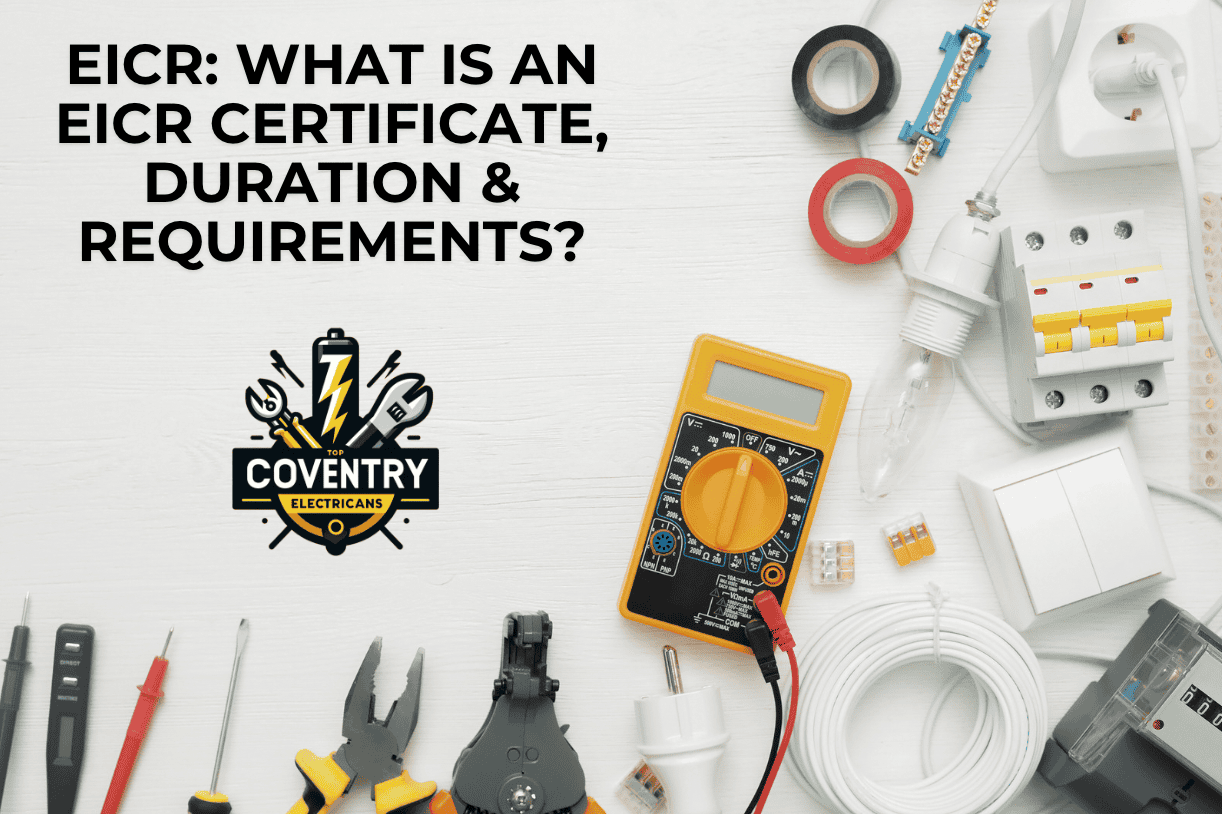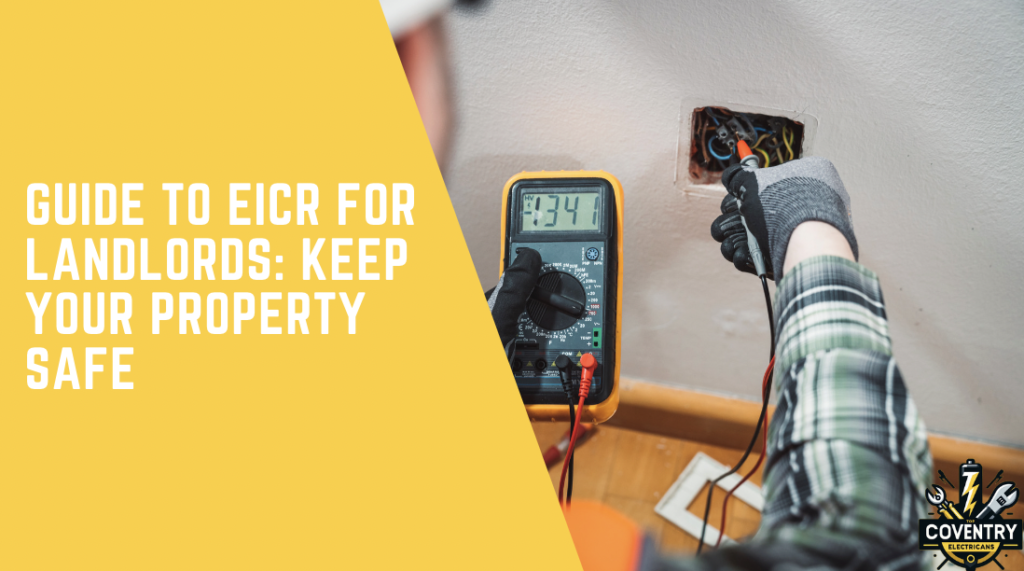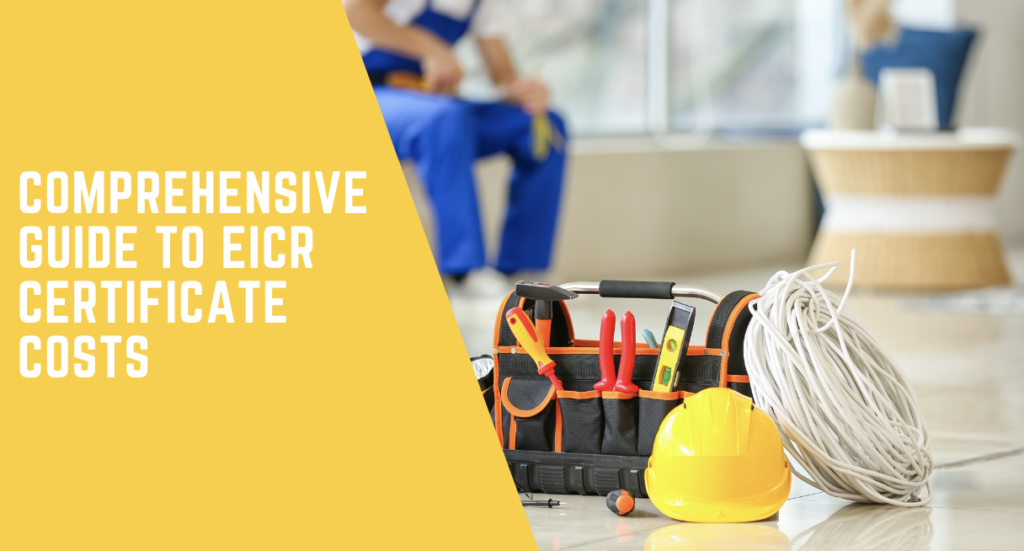

EICR: What Is An EICR Certificate, Duration & Requirements?
- ,
- , EICR
Key Facts On EICR Certificates:
- EICR Importance: Obtaining an EICR (Electrical Installation Condition Report) certificate is essential for ensuring electrical installations’ safety and legal compliance in residential, commercial, and rented properties. It helps identify potential hazards, prevent electrical accidents, and meet insurance requirements.
- Inspection Frequency: The recommended frequency for EICR inspections varies depending on the property type. Rented properties and commercial buildings require an inspection every five years, while owner-occupied homes should undergo an EICR every ten years. Properties with specialised installations like swimming pools may need more frequent inspections.
- Inspection Process: During an EICR inspection, a qualified electrician conducts a thorough visual examination and testing of the electrical installation, including wiring, distribution boards, earthing arrangements, and accessories. The inspection aims to identify defects, non-compliances, and potential hazards, which are categorised using a coding system (C1, C2, C3) based on the level of risk.
What Is An EICR Certificate?
An EICR certificate, short for Electrical Installation Condition Report, is a comprehensive document that assesses the safety and condition of an electrical installation on a property. It is prepared by a qualified and registered electrician who conducts tests and visual inspections to identify any potential hazards, defects, or non-compliance with the current wiring regulations.
The primary purpose of an EICR certificate is to ensure that the electrical systems in a building are safe to use and pose no risk of electrical shocks, fires, or other incidents that could endanger the occupants or cause damage to the property. This gives homeowners and landlords peace of mind that their properties are safe and compliant.
You can see a video below which goes through an Electrical Installation Condition Report from start to finish and provide any further information that you may need.
Why Is An EICR Necessary?
An EICR identifies imperfections, damage, deteriorations, and conditions that may indicate potential danger and provides recommendations for improvement within a property.
Obtaining an EICR certificate is crucial for several reasons:
- Safety: By identifying potential risks or hazards before they become a serious issue, an EICR plays a crucial role in preventing electrical accidents, fires, and other incidents that could endanger lives and property. Organisations like Electrical Safety First provide valuable resources on electrical safety for homes and businesses.
- Legal Compliance: An EICR certificate is often required for specific properties, such as rented accommodations or commercial buildings. Failure to comply with these regulations can result in hefty fines or legal actions.
- Insurance Purposes: Some insurance companies may require an up-to-date EICR certificate as a condition of coverage. Obtaining or renewing your insurance policy may be easier with a valid certificate. While it may seem demanding, this requirement provides financial protection for homeowners and landlords in case of electrical incidents or property damage.
- Property Maintenance: Regular EICR inspections help identify and address any issues before they become significant problems, prolonging the life of the electrical installation and reducing the need for costly repairs or replacements in the future.
Consequences Of Not Testing Electrical Systems
Neglecting to have your electrical systems tested and failing to obtain an EICR certificate can have severe consequences:
- Increased risk of electrical fires, shocks, and other hazards, putting the lives of occupants at risk.
- Potential legal repercussions, especially for landlords or commercial property owners who are required by law to have regular EICR inspections.
- Financial Vulnerability: Without an up-to-date EICR certificate, obtaining or renewing your insurance policy may be difficult, exposing you to electrical incidents or property damage with higher long-term costs due to the need for extensive repairs or replacements when issues are left unaddressed.
EICR Process & How Is It Carried Out?
An EICR inspection is a comprehensive process that thoroughly examines the entire electrical installation in a property. Here’s a general overview of how it’s carried out:
- Visual Inspection: The electrician will perform a detailed visual inspection of all electrical components, including wiring, distribution boards, consumer units, earthing arrangements, and accessories like light fittings and sockets.
- Testing: Various tests, such as continuity tests, insulation resistance tests, and earth fault loop impedance tests, will be conducted to assess the installation’s functionality and safety.
- Analysis: The electrician will analyse the results of the tests and visual inspections to identify any defects, non-compliance, or potential hazards.

Common Electrical Issues Revealed
Some of the common issues that can be revealed during an EICR inspection include:
- Damaged or deteriorated wiring or cable insulation
- Inadequate or faulty earthing arrangements
- Outdated or overloaded distribution boards or consumer units
- Lack of residual current devices (RCDs) or circuit breakers
- Electrical accessories or fittings that do not meet safety standards
Duration of an EICR Inspection
The duration of an EICR inspection can vary depending on the size and complexity of the property. On average, a typical residential property may take 2 to 4 hours, while more significant commercial or industrial buildings can take a full day or even longer.
Understanding EICR Results
After the inspection, the electrician will provide an EICR report outlining the findings and recommendations. The report will categorise any issues or defects using a coding system:
- C1 (Danger Present): This code indicates a potentially dangerous issue that poses an imminent risk of injury and requires immediate remedial action.
- C2 (Potentially Dangerous): While not an immediate danger, this code signifies a potentially hazardous issue that requires further investigation and remedial work without delay.
- C3 (Improvement Recommended): This code highlights areas where improvements are recommended, but the issue is not deemed immediately dangerous.
Timeframe For Correcting Issues
The timeframe for addressing any issues identified during the EICR inspection will depend on the severity of the defects:
- C1 issues (Danger Present) must be rectified immediately, as they pose an imminent risk of injury or damage.
- C2 issues (Potentially Dangerous) should be addressed within a reasonable timeframe, typically within a few weeks or months, depending on the specific problem.
- C3 issues (Improvement Recommended) can be addressed at your convenience, but it’s advisable to address them during your next scheduled electrical work or renovation.
Find out more information on this with our detailed EICR codes guide.
EICR Frequency Requirements
The frequency at which you need to obtain an EICR certificate for your property depends on the type of property and its usage:

For Landlords
- Rented properties: An EICR inspection is required every five years or whenever there is a change of tenancy, as outlined in the government’s guidance on electrical safety standards in the private rented sector.
- Houses in Multiple Occupations (HMOs): Depending on local regulations, EICR inspections may be required more frequently, typically every five years or less.
If you’re a landlord and want more information, why not take a look at our helpful guide – EICR For Landlords.
For Homeowners
- Owner-occupied homes: An EICR inspection is recommended every ten years or upon significant alterations or renovations to the property.
- Properties with swimming pools or other specialised installations may require more frequent EICR inspections, often annually.
After Receiving the EICR Certificate
Once you receive your EICR certificate, addressing any issues or defects identified in the report is essential. The certificate is typically valid for the recommended interval (e.g., 5 years for rented properties, 10 years for owner-occupied homes) unless significant alterations or renovations are made to the electrical installation, in which case a new EICR inspection may be required.
Tracking Next Inspection Due Date
It’s a good practice to track when your next EICR inspection is due, as failure to obtain a new certificate within the recommended timeframe can result in non-compliance with regulations and potential legal consequences. Some electricians or property management companies may offer reminder services to ensure you get your next inspection due date.
Cost Considerations
The cost of an EICR inspection can vary depending on several factors, such as:
- Location: Prices may be higher in areas with fewer electricians or higher living costs.
- Property Size: Larger properties typically require more time and effort, resulting in higher inspection costs.
- Property Age: Older properties with ageing electrical installations may require more extensive testing and inspection, leading to higher costs.
- Complexity: Properties with specialised installations (e.g., swimming pools and commercial kitchens) may incur higher fees due to the additional testing and expertise required.
On average, you can expect to pay between £150 and £350 for an EICR inspection on a typical residential property. However, it is always best to obtain quotes from multiple qualified electricians in your area to get an accurate estimate for your property.
Want to find out more about EICR Certificate Costs?
Ensuring a Smooth EICR Inspection
To ensure a smooth and efficient EICR inspection process, there are a few steps you can take to prepare:
- Clear Access: Make sure all electrical components, such as distribution boards, consumer units, and accessories, are easily accessible for the electrician. Remove any obstructions or clutter that may hinder their work.
- Provide Documentation: Have any relevant documentation, such as previous EICR reports or electrical installation certificates, readily available for the electrician to review.
- Inform Occupants: If you’re a landlord or property manager, inform all tenants or occupants about the scheduled EICR inspection and any potential disruptions or power outages that may occur during the process.
- Hire a Qualified Electrician: Always hire a certified and registered electrician to carry out EICR inspections. This ensures that the inspection is conducted to the highest standards and that the resulting certificate is valid and legally recognised.
By following these guidelines, you can help ensure a smooth and efficient EICR inspection process, ultimately contributing to the safety and compliance of your electrical installation.
FAQs On EICR Certificates
What do you mean by 'electrical installations'?
An electrical installation refers to the entire electrical system within a property, including all the wiring, cables, distribution boards, consumer units, switches, sockets, light fittings, and any other electrical components and equipment. During an EICR inspection, the qualified electrician thoroughly checks all aspects of the electrical installation to ensure it meets safety standards and complies with regulations.
Does the power have to be turned off when carrying out an EICR?
In most cases, the power does not need to be turned off for the entire duration of an EICR inspection. However, there may be brief periods when the electrician needs to isolate certain circuits or components to conduct specific tests safely. The electrician will ensure that any disruptions to the power supply are minimised and will inform the occupants in advance if any planned outages are necessary.
What is an EICR report, and what does it contain?
An EICR report is the comprehensive document the electrician provides after completing the inspection. It includes:
- Property Details and inspection date
- A schedule of inspections and tests conducted
- A schedule of circuits and electrical equipment inspected
- Observations and findings, categorized using the C1, C2, C3, and FI codes
- Recommendations for remedial work or improvements
- An overall condition assessment of the electrical installation
- Details of the next recommended inspection due date
- The electrician’s signature and certification
The report serves as a detailed inspection record, highlighting any issues and providing guidance on maintaining a safe and compliant electrical system.
Do I need an EICR if I Sell My House?
No, Although an EICR is not a legal requirement for selling your house or flat, obtaining one can be highly beneficial. You can find out more about this in our guide here.


